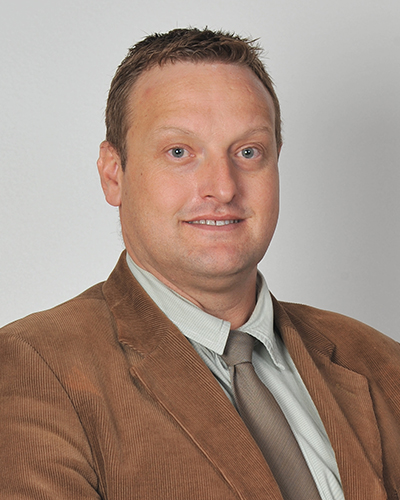
Prof Morgan Hauptfleisch
Qualification
Research interests:
As a wildlife and environmental scientist, Dr. Hauptfleisch’s interests lie in both research as well as conservation management and environmental protection. His research is therefore highly applied in nature in order to enhance environmental protection and nature conservation in Namibia and across the African continent. He holds key leadership positions within his discipline, among others:
- Board member for the International Association for Impact Assessment (IAIA);
- Council committee member for the Namibia Chamber of Environment;
- Board member for the Southern African Institute for Environmental Assessment.
Dr. Hauptfleisch is active in the field of environmental impact assessment and management. To this end he has been involved in the capacity assessment and development of Environmental Impact Assessment in Africa. He has provided capacity development for the World Bank, African Development Bank and others in Namibia, South Africa, Swaziland, Ethiopia, Ghana, Nigeria, Sierra Leone, Tanzania and Zanzibar. Together with the GIZ (Namibia and Germany) he has developed and implemented training in Ecosystem Assessment and Valuation and its integration into environmental and conservation disciplines in Namibia. He further collaborates with institutions such as the Namibian Chamber of Environment, World Wildlife Fund, Namibia Environment and Wildlife Society and the Environmental Investment Fund on the identification and mentorship of young Namibian conservation and environmental professionals.
Specifically, Dr. Hauptfleisch’s research interests fall within three major categories.
- Environmental impact assessment and management
With experience in mining environmental management and rehabilitation, he is currently conducting research on the quality of environmental impact assessment in Africa, and also on the role of biodiversity science in ensuring environmental impacts on biodiversity are accurately assessed and managed. A blog post outlining his philosophy on this subject can be found at this link https://iaia.org/news-details.php?ID=36 .
2.Wildlife ecology and management
With his cohort of post-graduate students and partnerships with among others St. Andrews University, Potsdam University, North-West University, Tubingen University, Dartmouth College and the Technical University of Munich this research area focuses mostly on the interactions between wildlife and vegetation productivity in different land uses in Namibia, as well as challenges to wildlife as a result of human impacts. This research is conducted on National Parks, Communal Conservancies and privately owned farms in Namibia. It has also recently spread to transboundary parks. This research also includes the use of technology to monitor wildlife across Namibia. The main area of interest here is the use of photogrametry and computer learning technology to count wildlife.
3.Unconventional human-wildlife conflict
Dr. Hauptfleisch interacts closely with the aviation industry on the minimization of birdstrikes. This research has seen him collaborate closely with the World Birdstrike Association and the Namibia Airports Company. Another form of unconventional human-wildlife conflict is urban reptile (mostly venomous snake) conflict. Here he collaborates with the charity organisation Snakes of Namibia in identifying causes of the conflict and participates in awareness activities in the safe handling and removal of snakes from urban locations in Windhoek.
Key publications:
Brown, O., Hauptfleisch, M., Jallow, H., & Tarr, P. (2012). Environmental assessment as a tool for peacebuilding, and development: Initial lessons from capacity building in Sierra Leone. In Assessing and Restoring Natural Resources in Post Conflict Peacebuilding (pp. 327–342). London: Earthscan. Retrieved from http://environmentalpeacebuilding.org/assets/Documents/LibraryItem_000_Doc_076.pdf
Equity in Extractives: Africa Progress Panel report for 2013. (n.d.). Retrieved from http://www.africaprogresspanel.org/wp-content/uploads/2013/08/2013_APR_Equity_in_Extractives_25062013_ENG_HR.pdf
Hauptfleisch, M. L., Vinte, M. P., & Blaum, N. (2017). A comparison of the community dynamics of bioturbating small mammals between livestock and wildlife farming areas in the Kalahari, Namibia. Namibian Journal of Environment, 1, A-39.
Hauptfleisch, ML. (2016). An aerial photographic survey of the Greater Fish River Canyon Landscape to estimate wildlife population densities and distribution. Namplace Project.
Hauptfleisch, Morgan. (2011). Cumulative effects analysis - Towns in the central Namib. In Strategic Environmental Assessment for the central Namib uranium rush (pp. 701–718). Retrieved from http://www.saiea.com/uranium/
Hauptfleisch, Morgan. (2016a). Secretive creatures of Namibia’s forgotten corner. Flamingo, (August), 26–29.
Hauptfleisch, Morgan. (2016b, December 16). The curious divide between conservation science and IA. Retrieved from http://www.iaia.org/news-details.php?ID=36
Hauptfleisch, Morgan, & Avenant, N. (2015). Integrating small mammal community variables into aircraft–wildlife collision management plans at Namibian airports. Integrative Zoology, 10(6), 515–530. https://doi.org/10.1111/1749-4877.12160
Hauptfleisch, Morgan, & D’Alton, C. (2015). Arthropod phototaxis and its possible effect on bird strike risk at two Namibian airports. Applied Ecology and Environmental Research, 13(4), 957–965.
Hauptfleisch, Morgan L. (2007). Monitoring the Sperrgebiet and adjacent areas: best practice guide for monitoring key indicators for the succulent Karoo ecosystem, with special focus on the Sperrgebiet National Park and adjacent areas. Windhoek, Namibia: Succulent Karoo Ecosystem Program.
Hauptfleisch, Morgan L., & Avenant, N. L. (2016). Actual and perceived collision risk for bird strikes at Namibian airports. Ostrich, 87(2), 161–171. https://doi.org/10.2989/00306525.2016.1186120
Hauptfleisch, Morgan L., Avenant, N. L., & Tsowaseb, A. (2013). Aircraft-wildlife collisions at two major Namibian Airports from 2006-2010. South African Journal of Wildlife Research, 43(2), 177–184.
Hauptfleisch, Morgan Lindo. (2008). Vegetation studies in the management of ungulates on the Bynespoort Game Park, Cullinan. Retrieved from http://repository.up.ac.za/handle/2263/25690
Hauptfleisch, Morgan Lindo. (2014). The use of ecosystem parameters in predicting the risk of aicraft-wildlife collisions at Namibian airports (Thesis). University of the Free State. Retrieved from http://scholar.ufs.ac.za:8080/xmlui/handle/11660/976
Hauptfleisch, Morgan, & Urban, S. (2017). Working towards a fence free Namib landscape. Roan News, 2017, 46–49.
Hauptfleisch, Morgan, Vigne, P., & Ellmies, R. (2011). Environmental Code of Practice for small-scale mining in the Erongo Region, Namibia. European Commission Namibia.
Hauptfleisch, Morgan, Vinte, M., & Rodgers, M. (2017). Nocturnal creatures that serve us diligently. Roan News, 2017, 20–23.
Morgan Hauptfleisch, Fernandu Khaebeb, & Katie Oxenham. (2016). What can small and meso-mammals tell us about biodiversity in conservancies? Roan News, 2016(1), 46–51.
Ntesa, C., & Hauptfleisch, M. (2014). Turning organic waste into a socio-economic resource. In “IAIA14 Conference Proceedings” Impact Assessment for Social and Economic Development. Vin Del Mar, Chile.
Rodgers, M., Bilton, M. C., & Hauptfleisch, M. L. (2017). Responses and feedbacks of burrowing mammals under differently managed rangelands. Namibian Journal of Environment, 1, A-51.
